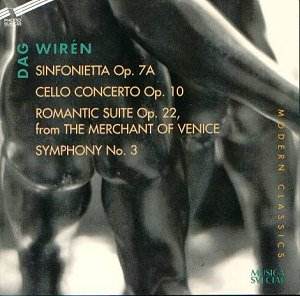Iíd actually never seen a photograph of Wirén
before receiving this for review. Here was a man whose most celebrated
critical comment (and albatross around his neck) was his artistic
credo beginning, with Biblical surety, I believe in Bach, Mozart,
Nielsen and absolute musicÖIt is indeed remarkable against
this background how his physiognomy resembles Nielsenís. If Wirén
saw himself as Son to Nielsenís Father the physical resemblance
is uncanny from the up and over quiff, tight lips, guarded eyes
and prominent ears. Leaving aside such matters for a moment, this
Phono Suecia disc traces Wirénís rather earlier self, from
the Opp. 7 and 10 to the Third Symphony of 1943-44 and the Op.
22 Romantic Suite derived from The Merchant of Venice Ė
by which point we are approaching the canonical Wirén.
The Sinfonietta was a leftover from an unsuccessful
attempt at a youthful Symphony begun in Paris. It starts with
genuinely motoric strength and has a second subject that is flooded
with a beautifully wistful song that soon leads on to a brassily
ceremonial section. The second movement is affectionate, full
of plangency and Nordic mist, with a solo trumpet coursing evocatively
and alone above the arching string line. Thereís incipient grandeur
here and a power that Wirén cleverly never quite unleashes.
The vista is embryonic Wirén and most impressive. Thereís
a martial finale with plenty of perkiness as well as some pawky
winds some sounding distinctly Sibelian. Off-beat pizzicati appear
whilst triumphant percussion are cut short by the conclusion authoritatively
carried off by the strings.
The Cello Concerto was composed in 1936 for Wirénís
great friend Gustav Gröndahl, who gave the premiere in Stockholm
three years later. It predates the famous Serenade by a year and
is a short, sixteen-minute work cast in three movements. The first
movement is imbued with a subtle march character, the solo cellist
exploring his line with tenacious grit, the brass becoming more
and more insistent. The movement becomes increasingly less discursively
pliant as it develops. There are some moments of reverie and reprieve
for the soloist. I was immediately struck by the slow central
movement which starts with real nobility but is almost immediately
cut abruptly short by a dramatic attacca subito episode. This
is actually the direction of the second movement of the Sinfonietta
but it applies equally Ė actually rather more accurately Ė to
this work. The end of the movement is somewhat modal and also
curiously and deftly antique in utterance, as if Wirén
were evoking some fictive past. The Allegro conclusion is chirpy,
melodic, full of expressive little orchestral moments and harmonic
individuality. I suppose critics would point to the slow movement
as being evidence of Wirénís relative brusqueness of melodic
inspiration. I prefer to see it as a curious and distinctive approach
to the concerto and to the function of the slow movement in particular.
The Romantic Suite from The Merchant of Venice
dates from 1943 (and very lightly revised in 1961). He wrote quite
a considerable amount of theatre music and these five, short movements
attest to his idiomatic understanding of the medium. The opening
is full of melancholy and its successors are rumbustious and jolly
with overtones of Stravinsky and Prokofiev. The Third Symphony
is the final and most impressive work here. It was written during
the War, between 1943 and 1944 though constantly interrupted by
Wirénís military service. Again this is in three conventional-appearing
movements, fast-slow-fast. It is a compact, incisive work, free
of extraneous and superficial matter. The first movement is thrustful,
with deep brass driving forward with a definably baleful menace.
The Adagio has a strong, sometimes yielding profile, but the lines
are long. Critics who complain Wirén is short winded should
listen. The harmonies are distinctive; the structure is tight,
the atmosphere sometimes aloof though not cold. The finale, the
longest of the three movements has a certain ambiguity at its
heart. The orchestration is splendid, and thereís real elasticity
in the writing, encompassing quicksilver changes of mood and emotive
states. The reflective passage at 8.30 is one of those "Wirén
moments," and the almost immediately eruptive Sibelian brass
(I think of the Fifth Symphony here) and their effulgent, burnished
confidence take the Symphony to the point of anticipatory triumph,
a belief in the future. The cymbal clash that leads to increased
elevated power ends the work in triumph.
Performances are strongly committed. Lidström
is a soloist who marries technique with expressive insight and
the Sami Sinfonietta and Stefan Solyom are accomplished exponents.
No complaints about the sound quality or about the precision of
the notes.
Jonathan Woolf

![]() Mats Lidström (cello)
Mats Lidström (cello)
![]() PHONO SUECIA PSCD 716
[71.53]
PHONO SUECIA PSCD 716
[71.53]